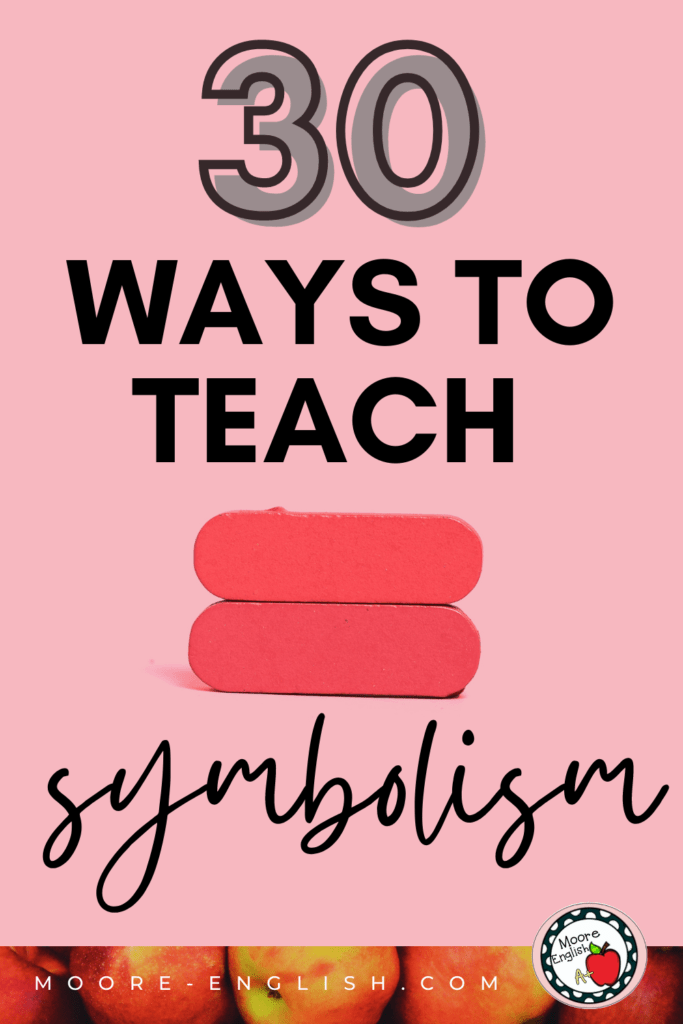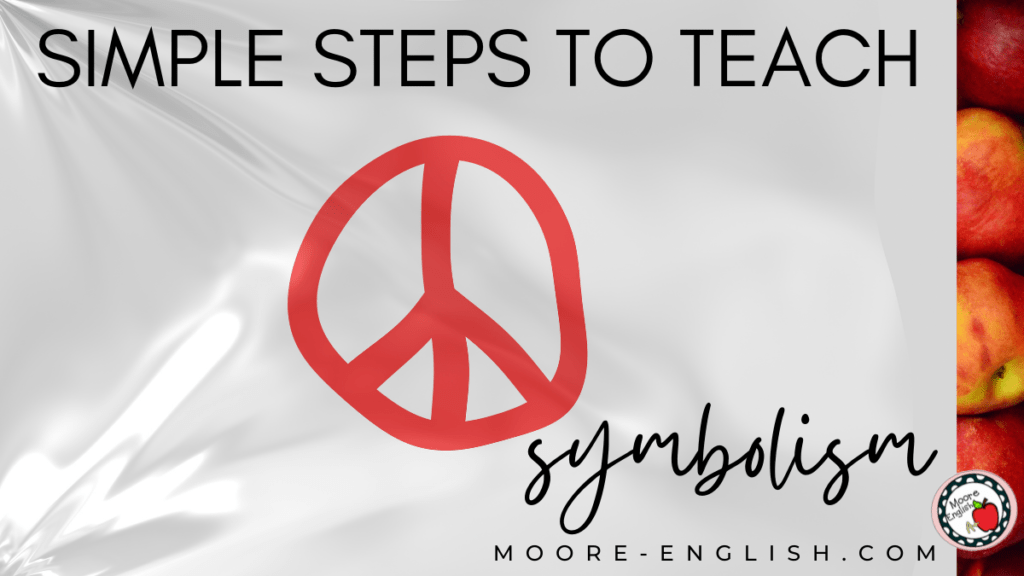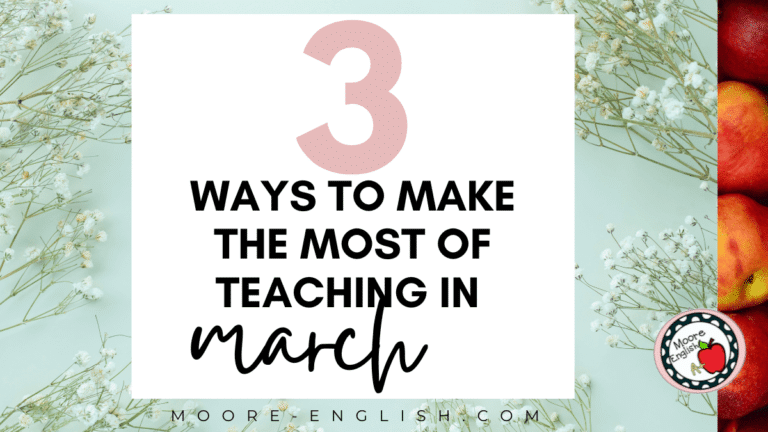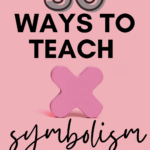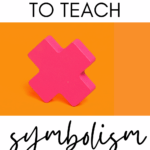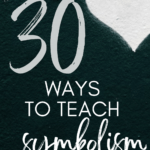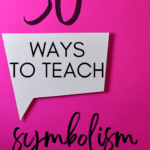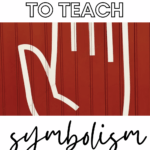My favorite poem is “Spring and Fall: To a Young Child” by Gerard Manley Hopkins. In the beginning of the poem, the speaker asks, “Margaret, are you grieving over Goldengrove unleaving?” Few symbols have captured my imagination like the “Goldengrove.” It’s a place I imagine as I’m falling asleep or when I need a moment of calm or even when I think I need a dose of humility.
Perhaps because of this poem, symbolism is one of my favorite topics. Helping students unpack the meaning of a symbol can help them unpack an entire texts. Symbols are such an important part of our world that analyzing symbolism is a skill that translates far beyond literature. Today, I wanted to share some of my favorite texts and strategies for teaching symbolism.
Cumulative Projects
Anytime I start an instructional cycle, I like to have my endgame in mind. Usually, teaching symbolism is part of a longer unit. However, sometimes symbolism is the entire point. Either way, these are two fun activities that can be used as cumulative projects when teaching symbolism.
First, the Book Cover Design Project is a personal favorite. During or after reading a text, students redesign the book cover to emphasize the story’s symbolism. How elaborate this project becomes is up to you, but this can be a fun presentation or something more informal.
Similarly, the Personal Coat of Arms project combines symbolism and the writing process. I often use this activity alongside Macbeth and Beowulf, but it’s also a good activity to use during stations. One thing I like about this activity is that it’s a neat way to get to know students while also emphasize writing skills. At the end, teachers can hang these gallery walk-style and let students read to get to know one another.
Introducing Symbolism
Over the years, I’ve used several different strategies and texts to introduce symbolism. As a new teacher, I made the mistake in believing that students would inherently understand what symbolism means. However, that was a mistake and an oversight. Now, I draw on these strategies to help students get a clear picture of symbolism.
First, the Ted Talk “Why city flags may be the worst-designed thing you’ve never noticed” by Roman Mars is a fun way to introduce symbolism. Before watching this talk, I had never really considered city flags. However, flags are clearly a symbolic bodies and evoke serious sentiments. This is a quick, easy-to-understand video. Plus, students can practice their design skills by creating their own flags. Watch it here.
Similarly, “We Wear the Mask” by Paul Laurence Dunbar is a good way to study symbolism. This poem often resonates with students for a number of reasons. First, Dunbar’s emphasis on race connects with social (in)justice issues happening in the world. Second, the idea of a symbolic “mask” resonates with a lot of high school students. Read it here.
Finally, for a short story, “A Worn Path” by Eudora Welty can be a good way to introduce symbolism. While I usually teach this poem with Regionalism, I have also used it to emphasize symbolism. I often use a symbol log to help students track all the different symbols in the text. Read it here.
Poetry Pairings for Teaching Symbolism
When choosing texts, I always look for a way to select texts that relate to one another. To my mind, text pairings is a good way to emphasize synthesis-level thinking in addition to any other skill we happen to be practicing. In the case of symbolism, it’s also interesting to see how several authors interpret the same or similar symbols.
- “Mercy” by Rudy Francisco and “Allowables” by Nikki Giovanni
- “Song of Myself” and the Preface to Leave of Grass by Walt Whitman
- “Slam, Dunk, and Hook” by Yusef Komunyakaa and “Home Court” by Jose Olivarez
- “Sympathy” by Paul Laurence Dunbar and “Caged Bird” by Maya Angelou
- “Zapotec Crossers (or, Haiku I Write Post-PTSD Nightmares)” and “Complaint of El Río Grande” by Richard Blanco
- “To Kill a Deer” by Carol Frost, “Deer Hunt” by Judson Jerome, and “Traveling in the Dark” by William Stafford
- “The New Colossus” by Emma Lazarus, “lady liberty” by Tato Laviera, and “Three Liberties: Past, Present, Yet to Come” by Julia Alvarez
Short Stories for Teaching Symbolism
While poetry pairings are a great way to make connections across texts, sometimes teachers need a longer text so students can evaluate the meaning of a symbol throughout. The way an author sustains the meaning of a symbol can lead to great classroom discussions. Plus, this provides students with greater opportunity to see how symbolism exists alongside other figurative devices. These short stories are each a good opportunity for teaching symbolism.
- First, “To Build a Fire” by Jack London is a straightforward short story with clear symbols. Students can discuss the meaning of the fire, the snow, and the setting. Plus, students usually find the main character so odious that they are always engaged. Read it here.
- Additionally, “A White Heron” by Sarah Orne Jewett features clear symbolism. The setting is also symbolic in this text, but the bird is the real star. This text also provides students with a chance to easily apply literary criticism. Read it here.
- Similarly, “Shooting an Elephant” by George Orwell also features a symbolic animal. While there is some controversy as to whether or not this text is fiction or memoir, the central elephant is clearly a symbol. I often teach this text alongside Things Fall Apart since the elephant can be interpreted as a failing imperial power. Read it here.
- Finally, “The Yellow Wall-paper” by Charlotte Perkins Gilman is a classic short story for a reason. The wall paper and the setting are strong symbols that carry and evolve throughout the text. The main character is also so memorable that students are sure to be engaged. Read it here.
Longer Works
Once students feel comfortable with symbolism, it’s time to graduate to long works. Especially in a novel or drama, students have the opportunity to see how symbolism relates to an author’s purpose and how symbolism works alongside figurative language.
- First, Beowulf features some straightforward symbols of bravery and heroism. Since Beowulf can be read in episodes rather than all at once, teachers can choose to focus on specific symbols.
- Next, Macbeth by William Shakespeare is a personal favorite. The dagger soliloquy is a perfect way to study symbolism. The sleeplessness motif in this drama is also a good way to apply psychoanalytical criticism.
- Additionally, To Kill a Mockingbird by Harper Lee is one of the first texts I ever used to teach symbolism. To help students work through various symbols in this text, I often rely on paired passages and frequent classroom discussions.
- Finally, The Great Gatsby by F. Scott Fitzgerald carries some of literature’s most enduring symbols. To help students navigate all these symbols and their ambiguities, I often employ this easy symbol log.
While Goldengrove is the literary symbol I think of mot often, there are countless memorable symbols sprinkled through literature. Which symbols mean the most to you?

